Coronavirus in charts: the fact-checkers correcting falsehoods
Data and infographic updates on the COVID-19 pandemic.
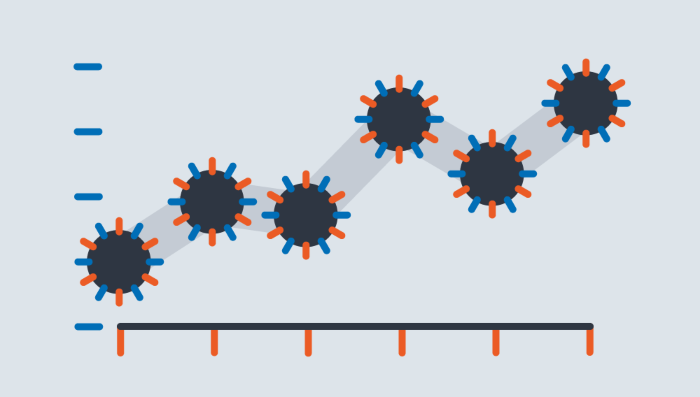
29 May — Battling the coronavirus ‘infodemic’
For researchers who track how information spreads, the COVID-19 pandemic is an experimental subject like no other. Misinformation, disinformation and conspiracy theories have spread widely online, and researchers are scrambling to track and analyse these falsehoods in the hope of understanding where such information comes from, how it grows and — they hope — how to elevate facts over fiction.
One team has tracked how malicious information about a pneumonia-like disease began circulating on the forum 4chan in December — and then quickly reached mainstream sites such as Facebook (see ‘Highways of hate’).

Meanwhile, social-media platforms often rely on fact-checkers at independent media organizations to flag up misleading content. In January, 88 media organizations worldwide joined together to record fact-checks of COVID-19 claims in a database (see ‘A fact-checking frenzy’). Social-media sites have done a decent job of removing misleading content, given the volume, say researchers. In one analysis, about 25% of claims flagged as false remained in place without a warning on YouTube and Facebook. Read more about the battle against coronavirus misinformation here.
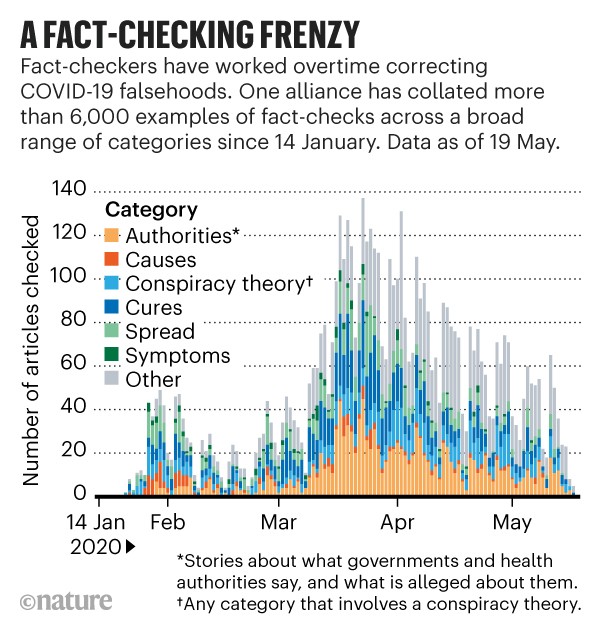
21 May — Coronavirus stopped flu in its tracks
Lockdowns and social-distancing measures aimed at slowing the spread of coronavirus seem to have shortened the influenza season in the northern hemisphere by about six weeks. Seasonal flu cases in the northern hemisphere usually peak in February and tail off by the end of May. This year, unusually, lab-confirmed cases of influenza dropped precipitously in early April, a few weeks after the coronavirus pandemic was declared on 11 March. The data comes from tests of more than 150,000 samples from national influenza laboratories in 71 countries that report data to FluNet, a global surveillance system.

20 May — How global lockdowns have slashed carbon emissions
Lockdowns have spurred tantalizing drops in carbon emissions around the world as cities, industries and transport have ground to a halt. Detailed estimates suggest that the international response to the coronavirus pandemic has so far slashed global carbon emissions by more than 8%. But energy consumption is already rebounding many places, as government-imposed restrictions are eased. Still, even as these measures are relaxed over the course of the year, one team projects that cumulative global emissions for 2020 could drop by 4–7%, which would represent the largest drop since the Second World War. Read more about how carbon emissions have changed amid the pandemic here.
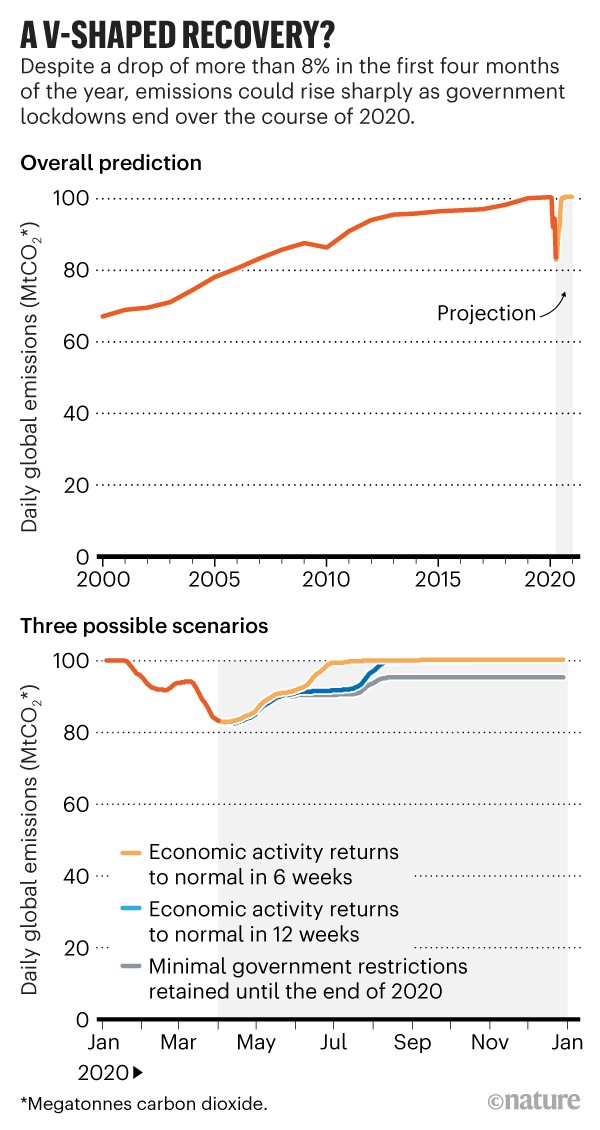
20 May — How female researchers are losing ground during the pandemic
Science’s gender publishing gap is well documented — but several analyses now show how lockdowns have exacerbated disparities in research productivity between men and women as home and work life clash. Data show that female academics are posting fewer preprints to repositories than before lockdowns started, and they are initiating a smaller proportion of research projects, as measured by new entries on registered-report databases. Sociologists say that women are likely to be shouldering more of the increased burden of childcare and domestic work under lockdowns.
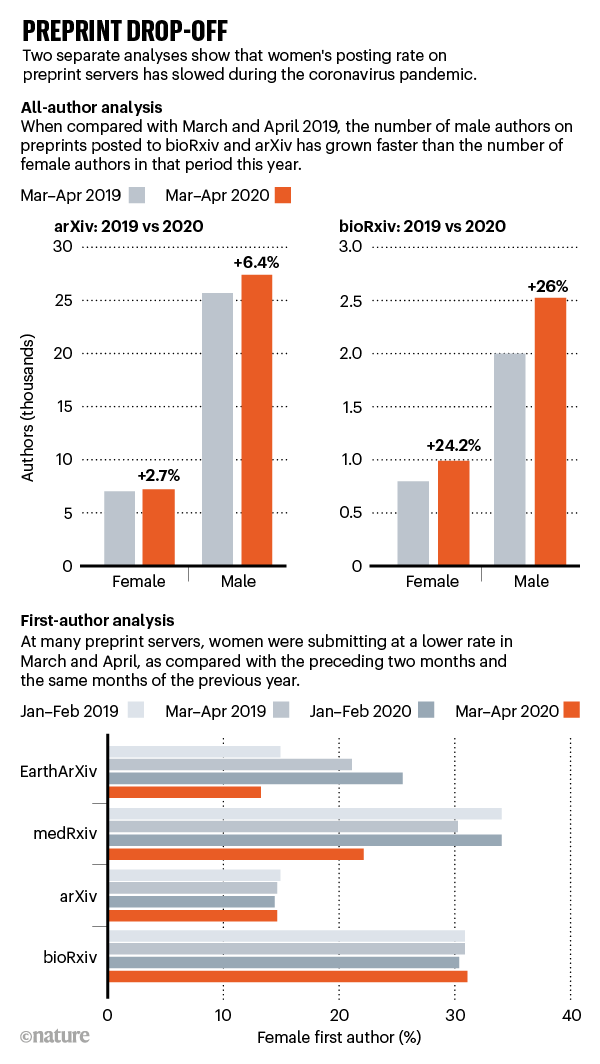
15 May — The protein structures that could help scientists disarm the coronavirus
From the moment the new coronavirus’s genome sequence was released in January, a network of structural biologists around the world redirected their labs towards a single goal — solving the protein structures of the deadly virus. With the structural information in hand, scientists can recreate the proteins in the lab, visualize them and then, hopefully, identify drug compounds to block them or develop vaccines to rally the immune system against them. Read more about the quest to solve and visualize the coronavirus’s protein structures here.
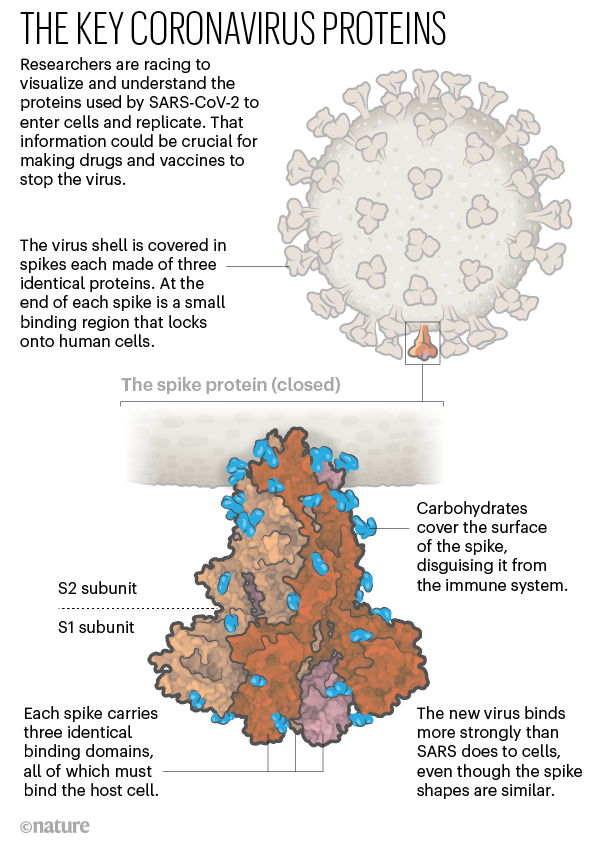
15 May — Online meetings find favour with scientists
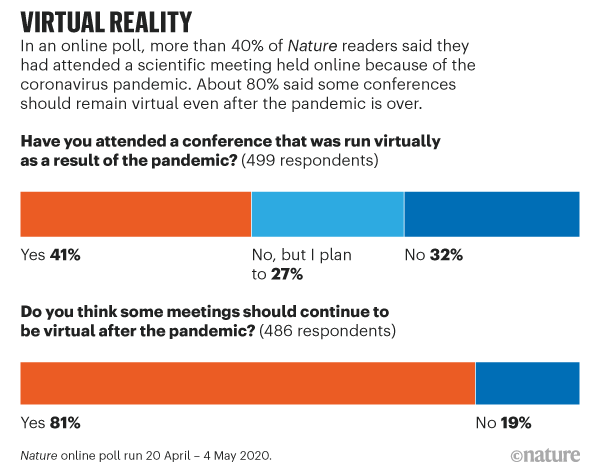
More than 80% of respondents to a Nature reader poll said that they would be in favour of some scientific conferences remaining virtual even after the coronavirus pandemic ends. Many meetings have been pushed online since March as a result of the global COVID-19 outbreak — including large, flagship conferences that usually attract thousands of attendees.
More than 40% of the roughly 500 survey respondents said that they had attended an online meeting.
Readers lauded some aspects of virtual meetings — in particular improved accessibility, low costs and avoiding the hassle of travel. “I know colleagues around the world with limited budgets who’ve also suddenly been able to attend many more meetings,” says Tom Brown, who studies energy-system modelling at Karlsruhe Institute of Technology in Germany. Some respondents found presentations to be clearer, liked that they could rewatch recorded talks, and felt that it is easier to speak up as an audience member using digital tools than it is in a meeting hall.
Downsides included clunky technology, connection issues and most notably, the lack of serendipitous encounters, human interaction and socializing.
But many respondents thought virtual conferences would improve in time and that the digital experience could help to make in-person meetings better, for instance through improving technologies that allow attendees to exchange data, knowledge and opinions during presentations.
Some advocated a hybrid model — a face-to-face meeting with increased virtual elements. “Some of the best parts of a conference, such as informal meetings, local flavour, and more time to talk to speakers after sessions were completely lost. A hybrid system might recover some of these benefits,” says Paul DeStefano, a physicist at Portland State University in Oregon.
11 May — Rapid peer review and blocking bad science
Preprint servers — where researchers post manuscripts before peer review — have been flooded with studies since the coronavirus pandemic began, in a bid to rapidly share information that could lead to vaccines and treatments and shape policies. But these repositories have had to beef up their screening processes to weed out poorly conducted studies that could be harmful, or fuel conspiracy theories.
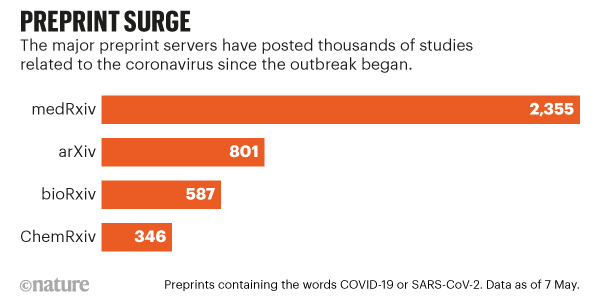
At the same time, journals are scrambling to rapidly review and publish studies. One analysis of titles found that the average time to publication had dropped from 117 to 60 days. Read more about science publishing during the pandemic here.
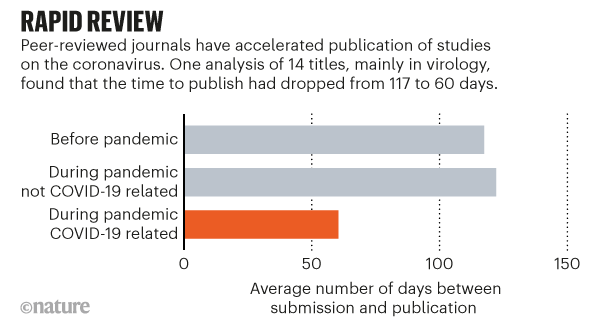
5 May — Paltry historical funding for coronavirus-related research
Before the COVID-19 pandemic, funding for research related to coronaviruses constituted just 0.5% of global spending on infectious-disease studies by public and philanthropic organizations. From 2000 to the start of this year, these organizations spent about US$550 million on coronavirus work, according to an analysis by researchers at the University of Southampton, UK. By comparison, Ebola-related research received $1.2 billion (1.1% of global spending).
Spending has risen to $985 million since the current outbreak began (see ‘Coronavirus cash’). About $275 million of COVID-19 research funding is focused on vaccine development, $40 million on therapeutics and $18 million on diagnostic tests. The researchers note that the spending has generally been reactive — explaining spikes in 2004 and 2015, after outbreaks of the coronaviruses that cause severe acute respiratory syndrome and Middle East respiratory syndrome, respectively.
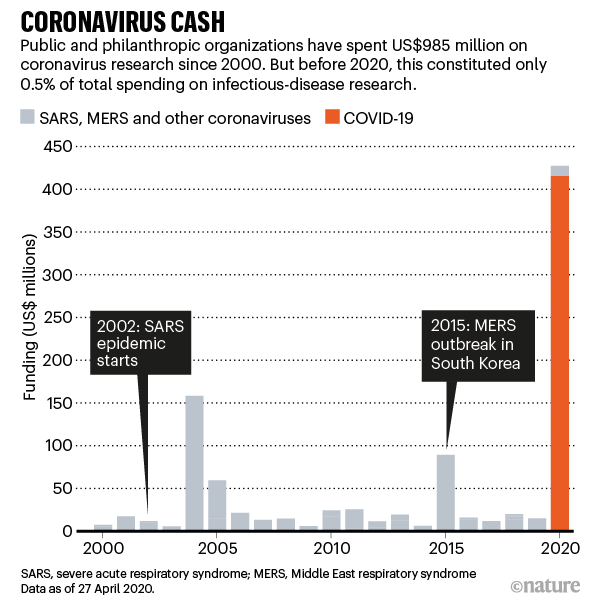
5 May — How the coronavirus breaks into human cells
Researchers are scrambling to uncover as much as possible about the biology of the latest coronavirus, named SARS-CoV-2 — and a profile of the killer is emerging. Scientists are learning that the virus has evolved an array of adaptations that make it much more lethal than the other coronaviruses humanity has met so far. Unlike its close relatives, SARS-CoV-2 can readily attack human cells at multiple points, with the lungs and the throat being the main targets (see ‘Deadly invader’). Read more about the complex biology of this killer virus here.
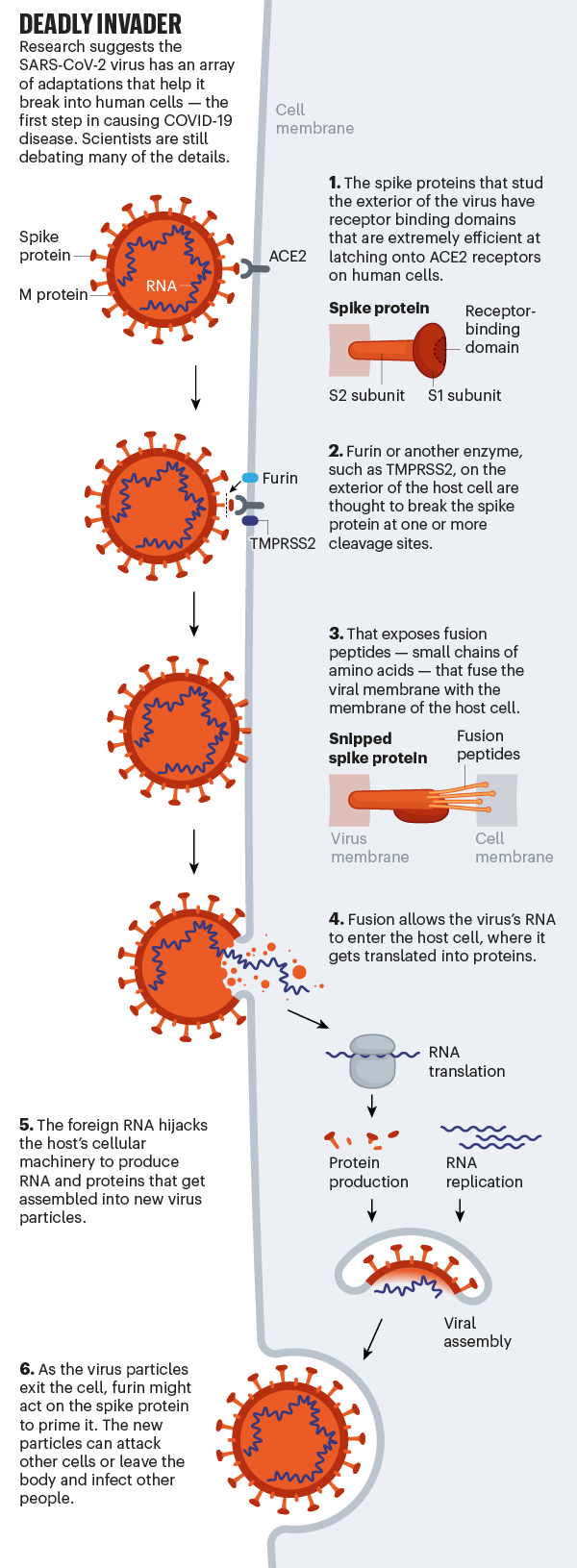
5 May — Which country had the strictest coronavirus response?
Nations have responded in vastly different ways to the coronavirus pandemic, and researchers are now sifting through data to work out which strategies — from wearing face masks to enforcing lockdowns — worked best. Scientists with the Oxford Coronavirus Government Response Tracker project have developed a ‘stringency index’ that scores a nation’s strategy on the basis of how strict it is, and allows approaches to be compared directly (see ‘Pandemic protections’). Read more about efforts to track the most effective strategies against COVID-19 here.
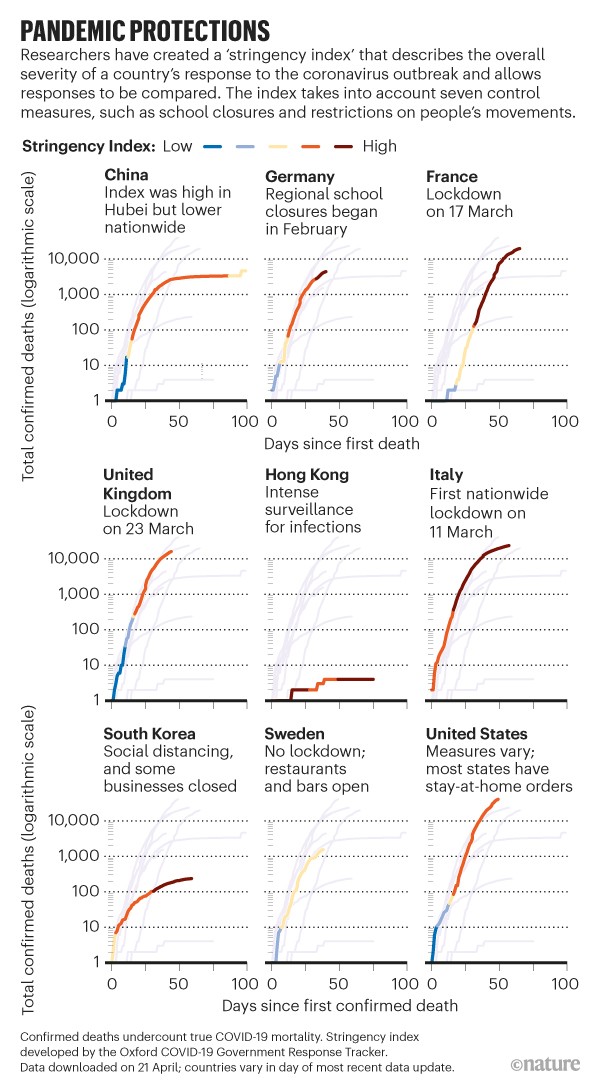
doi: 10.1038/d41586-020-01136-8